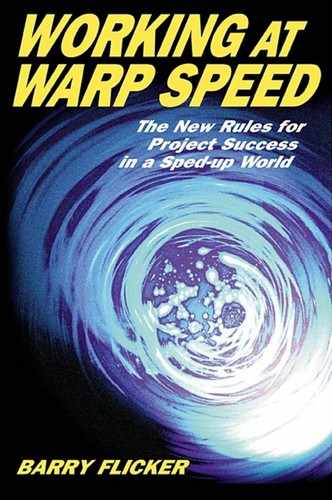5
Work from the Zone
Since you’re concerned about meeting resistance, let’s start by considering how we might gain the buy-in of others,” I said as I threw several scraps of paper on the floor. “For example, who wants to volunteer to clean up these scraps of paper?”
Nobody volunteered.
“Come on, Al. How about you?”
“Sorry, it’s not in my job description.”
“Ellen, can you help out?”
“How soon do you need it done?” she wanted to know.
“Right away.”
“That’s not possible. I’ve got half a dozen priority assignments that are already running late.”
“Somebody, please. Dave, what about you?”
“I’ve never really done that kind of work before,” he whined, to the delight of the group. “I really think you should give such an important assignment to somebody more experienced. How about Brenda?”
“Don’t you be looking at me,” said Brenda, “unless you’re going to tell me how to deal with all those excuses. What you just went through is what I face every single day.”
“Let’s run the experiment one more time,” I suggested.56
This time I grabbed a wad of bills from my pocket and tossed them into the air so that they fluttered to the floor. Amid the laughter, Christi pretended to lunge out of her seat eager to help me clean up the scattered twenty-dollar bills.
“See—no more excuses; now everybody wants to pitch in and help. Why?”
“There’s an obvious payoff,” said Ellen.
“Exactly. No convincing or arm twisting is required when the value of work is obvious. It happens automatically.”
“We don’t usually have the ability to offer cash bonuses at our level of the organization,” said Al.
“I use money because it makes for a quick, powerful demonstration. But that’s not what’s getting most people out of bed in the morning,” I replied. “People act on what they care about. If you want to motivate someone, you must understand what it is they value. If you can forge an unmistakable link between what they care about and what you want them to do, they will be lunging out of their chairs to help.”
“So instead of just asking people to complete a task, we could take the time to learn how our project could give them a chance to contribute and then build on that enthusiasm,” said Ellen.
“I like that approach,” said Christi. “You could point out how participating in your project might present them with the opportunity to sharpen a particular skill set, work with certain people they’d like to get to know, or learn about a new aspect of the technology.”
57
MOTIVATION
If you can forge an
unmistakable link
between your wants and
their values, they’ll
be lunging out of
their chairs to help.
“Those are noble sentiments,” said Ellen. “The question I want answered is, Are we going to do anything about them? I’ve wanted to sharpen my skill set and work with some new people for months, but it sure hasn’t worked out that way. Does this mean that you’ll finally help me get that transfer?” she asked Christi.58
The sudden intensity of Ellen’s remarks silenced the room so completely we could hear a distant lawn mower manicuring the grass somewhere on the campus. Finally, Christi spoke.
“Look, Ellen, I’m sorry you’re frustrated—I really am. I know you want to transfer to another department and I’m doing the best I can to accommodate you, but so far the opportunity hasn’t presented itself. Meanwhile, I have projects to run. I depend on the work you’re doing now to make that happen.”
“Ellen, let’s do a quick check-in. Right now are you in or out of the zone?” I asked her.
“Definitely out.”
“It sounds like you feel trapped.”
“I feel like I’ve tried everything,” she said, as if pleading her case.
“Feeling stuck or trapped triggers our fight-or-flight programming. Fight-or-flight knocks us out of the zone; overriding it opens the doorway back in. Here’s the trick. Suppose you knew, for a fact, that over the next few months, this situation would resolve itself in your best interest. Would you still feel angry and defensive?”
“Well, of course not, but I still wish I’d been treated better.”
“That still sounds angry and defensive. Defensiveness makes us react to our own fear instead of the full range of options available. That’s why it tends to be counterproductive. Here’s the deal: Would you be willing to totally let go of anger and defensiveness in return for a positive outcome to your problem?”
“Obviously I want to say yes, but it’s not so easy to do.”
“Is there anyone here who hasn’t faced a similar challenge at sometime?” I asked the group.59
Not only could everyone relate to Ellen’s predicament, but they were also very interested to see how it was going to resolve.
“When we’re trying to move from fight-or-flight back into the zone, there are three things it is helpful to keep in mind,” I suggested. “First, fight-or-flight feeds on feelings of isolation. The fact is, we’re in this together. As Brenda pointed out earlier, it doesn’t matter whose side of the boat the leak is on. If it sinks, we all go down.
“Second, fight-or-flight convinces us that we’re trapped in a life-and-death struggle. The fact is, there is always a way through. Our fear keeps us from seeing it by presenting a very limited and distorted picture of the situation. For that reason, the third thing you need to do is see where you really are.”
“I’m with you in theory,” said Ellen, “but practically speaking, how does any of this help my situation?”
“Why wouldn’t anyone help pick up the paper in the first experiment?” I asked her.
“They didn’t see anything in it for them.”
“Exactly. The instant people see a payoff they no longer need convincing. So what’s the payoff for Christi to send one of her most effective employees off to another department?”
“I see what you mean,” she said. “The way I set things up created a classic win/lose scenario. If I get what I want, Christi loses. If Christi gets what she wants, I lose. If I could define my next challenge in terms that would solve a problem for Christi rather than create one, she’d probably be more motivated to help me.”
60
ZONE GUIDELINES
- We’re in this together.
- There’s always a way through.
- See where you really are.
“Now you see where you really are,” I added. “You’re in a system with Christi and others. Once we accept that we’re in this together, we can begin to craft creative solutions that harness the forces that previously seemed to stand in our way. When we follow the current instead of resisting it, there’s always a way through.”61
“I have to take some responsibility for this situation as well,” said Christi. “First, I want to apologize, Ellen. I’ve been telling myself that I’ve been doing all I can to act on your request, but I see now that, to some degree, I have been avoiding it because I didn’t want to lose you. If you’re not happy, I’m going to lose you anyway. I have some ideas that I’d like to talk to you about later. But if those don’t suit you, I will make sure that we get you into a situation that will provide you with the challenges and rewards you deserve—even if that means losing you to another department.”
“Thanks. It feels really good to hear you say that,” said Ellen.
“I can’t tell you how relieved I feel to hear you both talking this way,” said Brenda. “We may all be in this together, but I’ve felt like I’ve been caught in the middle. I have been very upset over this situation.” She put her hand to her chest and began to laugh. “Oh, my gosh. I don’t think I realized how really bothered I was until just now.”
Warp speed urgency convinces us that we can’t afford to waste time sorting out messy conflicts. When we sweep these issues under the rug, they can take the whole team out of the zone, not just the people directly involved.
“Well, maybe we could put this approach to another real-world test,” said Christi.
“What did you have in mind?” I asked.
“Like Ellen, I also have a point of ongoing frustration with my boss—scope creep.”
“By ‘scope creep,’ you mean the addition of features and requirements without providing additional time or resources?” I asked her.62
“Exactly,” Christi replied. “If I say yes to an unreasonable request and then fail to deliver, I get blamed. If I say no, I sound uncooperative and it can easily become a power struggle. I’m sure I don’t need to spell out who gets the short end of the stick in a power struggle with my boss.”
“Yeah, and let’s not forget that ‘stuff’ rolls downhill,” Al quickly interjected. “What you promise gets passed on to Brenda to deliver, but it’s us worker bees that get stuck grinding out the impossible workload.”
Ellen and Dave both nodded in agreement.
“I noticed you referred to these encounters as a power struggle,” I commented. “The minute we see ourselves in a win/lose struggle, the fact that we’re in this together gets lost as well. Are you and Tom in this together?” I asked Christi.
“We better be or we’re history.”
“Then let’s take a look at where you really are, starting with the story you tell yourself that makes this look like a power struggle.”
“When difficulties arise around expanding scope, there’s a good chance Tom has been pressured by somebody else,” she replied. “I think sometimes he just wants to get the problem off his desk and dumps it on me.”
“Illegal dumping is always nasty business. What do you feel he should have done instead?” I asked.
“He should have taken a more active role in resolving the issue himself.”
“What’s the common theme in both Ellen’s and Christi’s conflicts?” I asked the group.
“They both felt mistreated,” said Dave.
“Isn’t that what generally knocks us out of the zone— how unfairly my husband or wife treated me, or my parents, or my best friend, or my boss? But now we know that there’s always a way through, so what can we do about it?”
“Get even,” said Al. 63
“That’s right, or we can go away. Those are the options our fight-or-flight thinking offers us. Where does that leave us?” I asked the group.
“It leaves us angry, frustrated, and at the mercy of the idiots out there,” said Ellen.
“Any suggestion that could help Christi shift her power struggle into a reciprocal relationship with Tom?” I asked.
Brenda had a suggestion. “We saw, in the Project Game, that things that look impossible may turn out to be more doable than we thought. Maybe the things that Tom asks us for are more doable than we think. Instead of immediately reacting we could suspend judgment until we’ve had a chance to run the numbers.”
“Good. We can avoid reacting prematurely. Any other ideas?”
“Plug the additional tasks into our project plan and take a look at the impact,” said Al.
“OK, and then…?”
“Review the results with the team at the next status meeting, and see if we can find a way to rework the plan to accommodate the change,” he continued.
“And if not?”
“Come up with three options that Christi can take back to Tom,” suggested Ellen.
“Thanks, everyone,” said Christi. “These are great suggestions, and I know that if I took the time to go through these steps, Tom would be very responsive. With the right information and a positive attitude, we would find a way to work through these scope changes to provide a better outcome for the customer while causing less wear and tear on all of us. Unfortunately, I get so sped up I forget to do what I already know.”
“That’s why proper pacing is so critical. We’re in this together, but it won’t feel that way if I move so fast that I run right by you. There’s always a way through, but if, in my hurry, I spend all my energy paddling against the current, it’s going to be a long and painful journey. If we’re going to see where we really are, we better take a moment to slow down.”64
“Who has time for any of that?” asked Al.
Although I knew he was more or less kidding, Al’s comment reminded me to slow down myself and review the essential ideas we had covered.
- Zone Guidelines include “We’re in this together,” “There is always a way through,” and “See where you really are.”
- If you want to motivate people, forge an unmistakable link between your wants and their values, and they will be lunging out of their chairs to help.
- Warp speed urgency convinces us that we can’t afford to waste time sorting out messy conflicts. When we sweep these issues under the rug they can take the whole team out of the zone, not just the people directly involved.
- Defensiveness makes us react to our own fear instead of the full range of options available. That’s why it tends to be counterproductive.
- With the right information and a positive attitude, we can find a way to work through scope changes that provide a better outcome for the customer while causing less wear and tear for the team. 65
Working from the zone calls attention to how we are feeling. Some people operate under the misconception that having or expressing feelings at work is, in and of itself, unprofessional. Feelings are not a biological mistake. They are an essential part of our ability to work together and succeed. How we feel impacts how we think and behave. Our behavior, in turn, influences how we feel. For example, when we become overloaded, we feel stress and anxiety, which eventually lowers our performance and efficiency. That’s why effective pacing is so important. Working from the zone and proper pacing go hand in glove, which is why it was the focus of our next inquiry.
66
